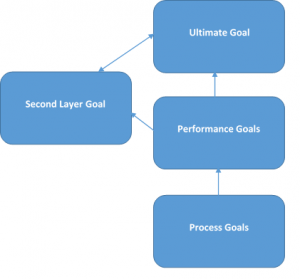Posted on April 07, 2016 by Jenny Cromack
This article was inspired by my current PhD studies and also my experience working with clients in both an exercise and rehabilitation setting. We hear a lot about goal setting (especially from me) and it’s importance for improving our motivation, confidence, and exercise persistence. What do we do when we don’t hit our goals though? If you are anything like me, this can be hugely demotivating and frustrating, which makes you question “why am I even bothering with this?”
When my personal training clients and I sit down to set their goals I have started adding a new approach. My new approach is what I have termed layering goals. When setting yourself an ultimate goal, think about what other things may improve as I work towards this and what would I be happy with in these areas? If you make a note of these as a second “layer” to your goal it may act as a “safety net” for your motivation. They are separate to your short term goals, and almost like “side effects” or layers to your goal.
Goals should be realistic as part of the goal setting process and therefore should be achievable, but in the event of goal failure this safety net may bring out other positive achievements for you to maintain your motivation and satisfaction. The following example highlights how this may look:
Let’s say my goal was physique related and I wanted to be 80kg at 10% body fat. This is my ultimate goal, but as part of this process I will be progressing my volume and intensity of my training. A side effect of this would be an improvement of strength. So as a second layer to my goal I may include a strength improvement in my goal plan, such as a 5% improvement over specific lifts such as my squat, bench, and deadlift. The process goals will obviously aimed towards my ultimate goal of body composition but I recognise that my strength will improve as a result so this second layer is feasible. The second layer should not be too out of reach and again be realistic.
The second layer is there for me to fall back on. So if I get to the end of my program and my weight has only hit 76kg and body fat is still sitting at 13% I can look back over my lifts and because I have this second layer to my goal I have a second opportunity for success and thus a motivation to continue.
This may be a good addition to your goal setting process (see image below) and provide more opportunities for success.



